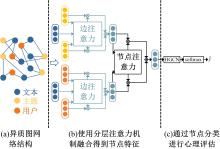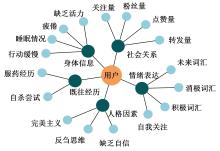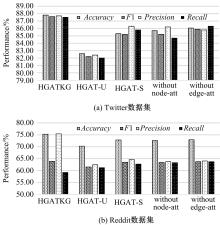吉林大学学报(工学版) ›› 2024, Vol. 54 ›› Issue (4): 1078-1085.doi: 10.13229/j.cnki.jdxbgxb.20220704
• 计算机科学与技术 • 上一篇
基于异质图网络的心理评估方法
- 1.天津大学 电气自动化与信息工程学院,天津 300072
2.天津城建大学 计算机与信息工程学院,天津 300384
Psychological assessment method based on heterogeneous graph network
Zhi-gang JIN1( ),Ren-jun SU1,Xiao-fang ZHAO2
),Ren-jun SU1,Xiao-fang ZHAO2
- 1.School of Electrical and Information Engineering,Tianjin University,Tianjin 300072,China
2.School of Computer and Information Engineering,Tianjin Chengjian University,Tianjin 300384,China
摘要:
针对现有利用社交媒体数据通过计算机技术进行心理评估的方法存在语义稀疏和缺乏先验知识融入的问题,提出了基于异质图网络的心理评估方法,提取社交媒体上的用户画像信息、文本信息、主题信息,构建异质图,将心理评估问题描述为节点分类问题。一方面,构建用户心理状态知识图谱融入先验知识,表征用户画像信息;另一方面,利用异质图融合信息进行语义补充,通过分层注意力关注节点权重,得到评估结果。在Twitter和Reddit数据集上进行实验,结果证明了本文方法在用户心理状态分类上的有效性,且关键性能明显提升。
中图分类号:
- TP183
| 1 | World Health Organization. World Mental Health Report: Transforming Mental Health for All[M]. Geneva: World Health Organization, 2022. |
| 2 | Coppersmith G, Dredze M, Harman C. Quantifying mental health signals in Twitter[C]∥Proceedings of the Workshop on Computational Linguistics and Clinical Psychology, Baltimore, USA, 2014: 51-60. |
| 3 | Shen G, Jia J, Nie L, et al. Depression detection via harvesting social media: A multimodal dictionary learning solution[C]∥Proceedings of the Twenty-Sixth International Joint Conference on Artificial Intelligence, Melbourne, Australia, 2017: 3838-3844. |
| 4 | Ive J, Gkotsis G, Dutta R, et al. Hierarchical neural model with attention mechanisms for the classification of social media text related to mental health[C]∥Proceedings of the Fifth Workshop on Computational Linguistics and Clinical Psychology: From Keyboard to Clinic, New Orleans, USA, 2018: 69-77. |
| 5 | Song X, Ming Z Y, Nie L, et al. Volunteerism tendency prediction via harvesting multiple social networks[J]. ACM Transactions on Information Systems, 2016, 34(2): 1-27. |
| 6 | 董飒, 刘大有, 李丽娜, 等. 基于类传播分布的关系近邻异质性网络分类方法[J]. 吉林大学学报: 工学版, 2016, 46(2): 522-527. |
| Dong Sa, Liu Da-you, Li Li-na, et al. Relational neighbor algorithm based on class propagation distributions for classification in networked data with heterophily[J]. Journal of Jilin University (Engineering and Technology Edition), 2016, 46(2): 522-527. | |
| 7 | Yang T, Hu L, Shi C, et al. HGAT: Heterogeneous graph attention networks for semi-supervised short text classification[J]. ACM Transactions on Information Systems, 2021, 39(3): 1-29. |
| 8 | Cao L, Zhang H, Feng L. Building and using personal knowledge graph to improve suicidal ideation detection on social media[J]. IEEE Transactions on Multimedia, 2022, 24: 87-102. |
| 9 | 黎才茂, 陈少凡, 林成蓉, 等. 基于知识图谱的多粒度社交网络用户画像构建方法[J]. 吉林大学学报: 工学版, 2022, 52(12): 2947-2953. |
| Li Cai-mao, Chen Shao-fan, Lin Cheng-rong, et al. Multi-grained social network user portrait construction method based on knowledge graph[J]. Journal of Jilin University (Engineering and Technology Edition), 2022, 52(12): 2947-2953. | |
| 10 | 王雨吟, 林锦婵, 潘俊豪. 个体认知-抑郁模型: 自我怜悯、完美主义、反刍思维和抑郁的关系[J]. 中国临床心理学杂志, 2015, 23(1): 120-123, 128. |
| Wang Yu-yin, Lin Jin-chan, Pan Jun-hao. The relationships among self-compassion perfectionism, rumination and depression[J]. Chinese Journal of Clinical Psychology, 2015, 23(1): 120-123, 128. | |
| 11 | Miller George A. WordNet: a lexical database for English[J]. Communications of the ACM, 1995, 38(11): 39-41. |
| 12 | Qi F, Yang C, Liu Z, et al. OpenHowNet: an open sememe-based lexical knowledge base[EB/OL]. [2022-08-19].. |
| 13 | Blei D M, Ng A Y, Jordan M I. Latent dirichlet allocation[J]. Journal of Machine Learning Research, 2003, 3: 993-1022. |
| 14 | Kayalvizhi S, Durairaj T, Chakravarthi B R,et al. Findings of the shared task on detecting signs of depression from social media[C]∥Proceedings of the Second Workshop on Language Technology for Equality, Diversity and Inclusion, Dublin, Ireland, 2022: 331-338. |
| 15 | Kayalvizhi S, Thenmozhi D. Data set creation and empirical analysis for detecting signs of depression from social media postings[EB/OL]. [2022-08-19]. . |
| 16 | Song X, Nie L, Zhang L, et al. Multiple social network learning and its application in volunteerism tendency prediction[C]∥Proceedings of the 38th International ACM SIGIR Conference on Research and Development in Information Retrieval, Santiago, Chile, 2015: 213-222. |
| 17 | Rolet A, Cuturi M, Peyré G. Fast dictionary learning with a smoothed wasserstein loss[C]∥Proceedings of the 19th International Conference on Artificial Intelligence and Statistics, Cadiz, Spain, 2016: 630-638. |
| 18 | Pedregosa F, Varoquaux G, Gramfort A, et al. Scikit-learn: Machine learning in Python[J]. Journal of Machine Learning Research, 2011, 12: 2825-2830. |
| 19 | Gui T, Zhu L, Zhang Q, et al. Cooperative multimodal approach to depression detection in Twitter[C]∥ Proceedings of the Thirty-Third AAAI Conference on Artificial Intelligence and Thirty-First Innovative Applications of Artificial Intelligence Conference and Ninth AAAI Symposium on Educational Advances in Artificial Intelligence, Honolulu, USA, 2019: 110-117. |
| 20 | Devlin J, Chang M W, Lee K, et al. BERT: Pre-training of deep bidirectional transformers for language understanding[C]∥Proceedings of the 2019 Conference of the North American Chapter of the Association for Computational Linguistics, Minneapolis, Minnesota, 2019: 4171-4186. |
| 21 | Liu Y, Ott M, Goyal N, et al. RoBERTa: A robustly optimized BERT pretraining approach[EB/OL]. [2022-08-19]. . |
| 22 | Nam H, Ha J W, Kim J. Dual attention networks for multimodal reasoning and matching[C]∥Proceedings of the IEEE Conference on Computer Vision and Pattern Recognition, Honolulu, USA, 2017: 299-307. |
| 23 | Moon S, Neves L, Carvalho V. Multimodal named entity disambiguation for noisy social media posts[C]∥Proceedings of the 56th Annual Meeting of the Association for Computational Linguistics, Melbourne, Australia, 2018: 2000-2008. |
| 24 | Poświata R, Perełkiewicz M. OPI@ LT-EDI-ACL2022: Detecting signs of depression from social media text using RoBERTa pre-trained language models[C]∥Proceedings of the Second Workshop on Language Technology for Equality, Diversity and Inclusion, Dublin, Ireland, 2022: 276-282. |
| [1] | 高敬鹏,王国轩,高路. 基于异步合作更新的LSTM-MADDPG多智能体协同决策算法[J]. 吉林大学学报(工学版), 2024, 54(3): 797-806. |
| [2] | 姜文明,齐立忠,张苏,荣经国,武宏波,左超,张晓龙. 基于知识图谱的电网工程建筑信息模型质量检查方法[J]. 吉林大学学报(工学版), 2024, 54(3): 807-814. |
| [3] | 刘浏,丁鲲,刘姗姗,刘茗. 基于机器阅读理解的事件检测方法[J]. 吉林大学学报(工学版), 2024, 54(2): 533-539. |
| [4] | 李健,熊琦,胡雅婷,刘孔宇. 基于Transformer和隐马尔科夫模型的中文命名实体识别方法[J]. 吉林大学学报(工学版), 2023, 53(5): 1427-1434. |
| [5] | 刘春晖,王思长,郑策,陈秀连,郝春蕾. 基于深度学习的室内导航机器人避障规划算法[J]. 吉林大学学报(工学版), 2023, 53(12): 3558-3564. |
| [6] | 白天,徐明蔚,刘思铭,张佶安,王喆. 基于深度神经网络的诉辩文本争议焦点识别[J]. 吉林大学学报(工学版), 2022, 52(8): 1872-1880. |
| [7] | 王生生,姜林延,杨永波. 基于最优传输特征选择的医学图像分割迁移学习[J]. 吉林大学学报(工学版), 2022, 52(7): 1626-1638. |
| [8] | 王文军,余银峰. 考虑数据稀疏的知识图谱缺失连接自动补全算法[J]. 吉林大学学报(工学版), 2022, 52(6): 1428-1433. |
| [9] | 田皓宇,马昕,李贻斌. 基于骨架信息的异常步态识别方法[J]. 吉林大学学报(工学版), 2022, 52(4): 725-737. |
| [10] | 刘勇,徐雷,张楚晗. 面向文本游戏的深度强化学习模型[J]. 吉林大学学报(工学版), 2022, 52(3): 666-674. |
| [11] | 黎才茂,陈少凡,林成蓉,林昊,陈秋红. 基于知识图谱的多粒度社交网络用户画像构建方法[J]. 吉林大学学报(工学版), 2022, 52(12): 2947-2953. |
| [12] | 黎才茂,陈少凡,林成蓉,候玉权,李浩. 基于循环知识图谱的虚拟社区知识动态推荐方法[J]. 吉林大学学报(工学版), 2022, 52(10): 2385-2390. |
| [13] | 李志华,张烨超,詹国华. 三维水声海底地形地貌实时拼接与可视化[J]. 吉林大学学报(工学版), 2022, 52(1): 180-186. |
| [14] | 雷景佩,欧阳丹彤,张立明. 基于知识图谱嵌入的定义域值域约束补全方法[J]. 吉林大学学报(工学版), 2022, 52(1): 154-161. |
| [15] | 欧阳丹彤,张必歌,田乃予,张立明. 结合格局检测与局部搜索的故障数据缩减方法[J]. 吉林大学学报(工学版), 2021, 51(6): 2144-2153. |
|
||





